Mushrooms in lawns and gardens provoke varying reactions, ranging from disgust at unsightly fungi sprouting through bark mulch to enchanted delight at a fairy ring gracing the yard. Regardless of your response, you may ask yourself: why are mushrooms growing in my garden? Where did they come from?
Quick answer: Mushrooms are a sign of a healthy ecosystem.
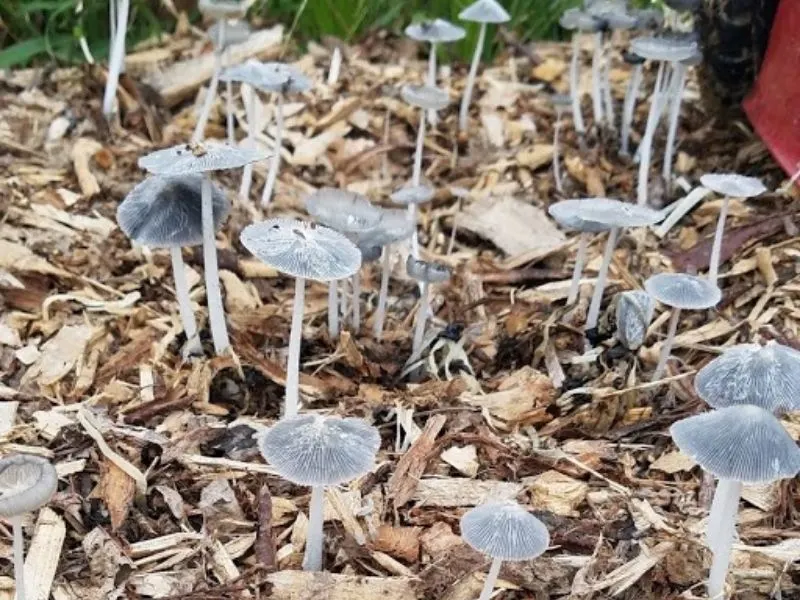
Why Are Mushrooms Growing in My Garden?
If you find a significant amount of mushrooms in your garden or lawn, you’ve likely had some wet, humid weather recently, or perhaps the area is well irrigated. In addition to the moisture, the fungi probably take advantage of a good source of decaying organic matter, like old roots, tree stumps, leaves, or even bark mulch.
What causes mushrooms in my lawn and garden?
Mushrooms release tiny spores that travel through the air and germinate in favorable conditions. As mentioned above, this is typically a moist, shady spot with plenty of organic matter. Once they land, these spores send out long, thin filaments that eventually form visible masses called mycelia, which decompose the organic material and absorb some of the nutrients.
The mushrooms you see emerging in your garden are just the aboveground fruiting bodies of belowground fungi. These fungi often live in the soil for several years, only producing mushrooms when the conditions are just right.
Are mushrooms in my garden bad?
Mushroom growth is not bad for your garden; in fact, mushrooms can be beneficial and are often a sign of a healthy lawn or garden! In decomposing organic matter, mushrooms increase the availability of nutrients to plant roots, thus contributing to rich, healthy soil. Think of them as the fungal version of an earthworm.
One group of fungi, called mycorrhizae, actually directly helps plants absorb water and nutrients through their root systems, in turn receiving sugars and amino acids.
You may remember learning about symbiotic relationships in biology class: this is a classic example. Mycorrhizae associated with many trees and shrubs produce visible mushrooms. It’s important to note that oaks, pines, and many other trees will grow poorly (or not at all) without their mycorrhizal partners.
What to do about mushrooms in the lawn or garden
When you see mushrooms in your garden, rejoice! They indicate healthy soil and help break down nutrients to feed your plants. However, if you dislike the appearance of these beneficial fungi, know that the delicate fruiting bodies tend to be short-lived and will quickly disappear on their own.
You can also remove mushrooms by hand or run over them with a lawnmower. If you catch them early enough, you can prevent the spores from spreading.
Of course, getting rid of the entire organism is nearly impossible, with its spreading mycelium, and doing so would harm the surrounding soil and plants. Just as plucking fruit from a tree won’t harm the tree, removing mushrooms from the soil won’t kill the fungus that produces them.
Types Of Mushrooms Found In Gardens And Yards
If you have decomposing organic matter on your property, mushrooms will find their way there. Here are some of the most common mushrooms that could be popping up in your garden:
- Puffball Mushrooms (Calvatia spp.) are distinctive, round fungi that can appear overnight in healthy gardens and lawns. Initially resembling small white balls, they grow quickly, and then the outer skin ruptures, exposing a mass of powdery spores inside. Puffballs are often found in areas with decaying wood, organic debris, or rich soil.
- Inky Cap Mushrooms (Coprinoid species) are known for their cap that dissolves into an inky liquid; these mushrooms often pop up in lawns, mulched areas, or gardens with rich organic content.
- Fairy Ring Mushrooms (Agaricus spp.) form distinctive rings in lawns and grassy areas due to an underground mycelium network decomposing organic matter.
- Bird’s Nest Fungi (Cyathus spp.): Small cup-shaped fungi resembling bird nests can appear in gardens, particularly in mulched areas with decaying plant material.
The appearance of these volunteer mushrooms varies. Sizes are from tiny to small, and then some giant ones. As for color, I’ve seen translucent, gray, white, brown, and shades of pink and orange (the stinkhorns).
Pictures Of Mushrooms Growing in Gardens
These are mushrooms I found last season in my own garden and yard. Some look cute, but others (like the stinkhorn mushroom) almost caused me to throw up.
Fairy ring mushroom (Marasmius oreades)

Ranging from one to twelve (or more!) feet in diameter, fairy rings get their whimsical name from the ancient belief that circles of mushrooms grow where fairies dance. Whether or not mushrooms are present, fairy rings can cause dark green, circular bands to form in the grass, a result of the nutrients released from the activity of the mycelium. Sometimes, however, the fungal growth in the center of the ring becomes so concentrated that water cannot permeate, and the grass above dies.
In this case, the best remedy is to improve water penetration by aerating the soil. Use a trowel, shovel, or screwdriver to determine the depth of the fungal mat. A lawn aerator should do the trick if it’s less than three inches deep. Thicker fungal mats, however, may require a shovel or small auger to penetrate fully. Be careful not to drop any pieces of the fungus onto the unaffected lawn, and thoroughly clean any tools used. Reseed if necessary, and water the treated area well.
Stinkhorn mushrooms

These first appeared at the base of our asparagus plants. I smelled them before I saw them. And while they are nasty-looking and really smelly, they are not bad for your garden. Learn more about stinkhorns.
Bird’s nest mushrooms
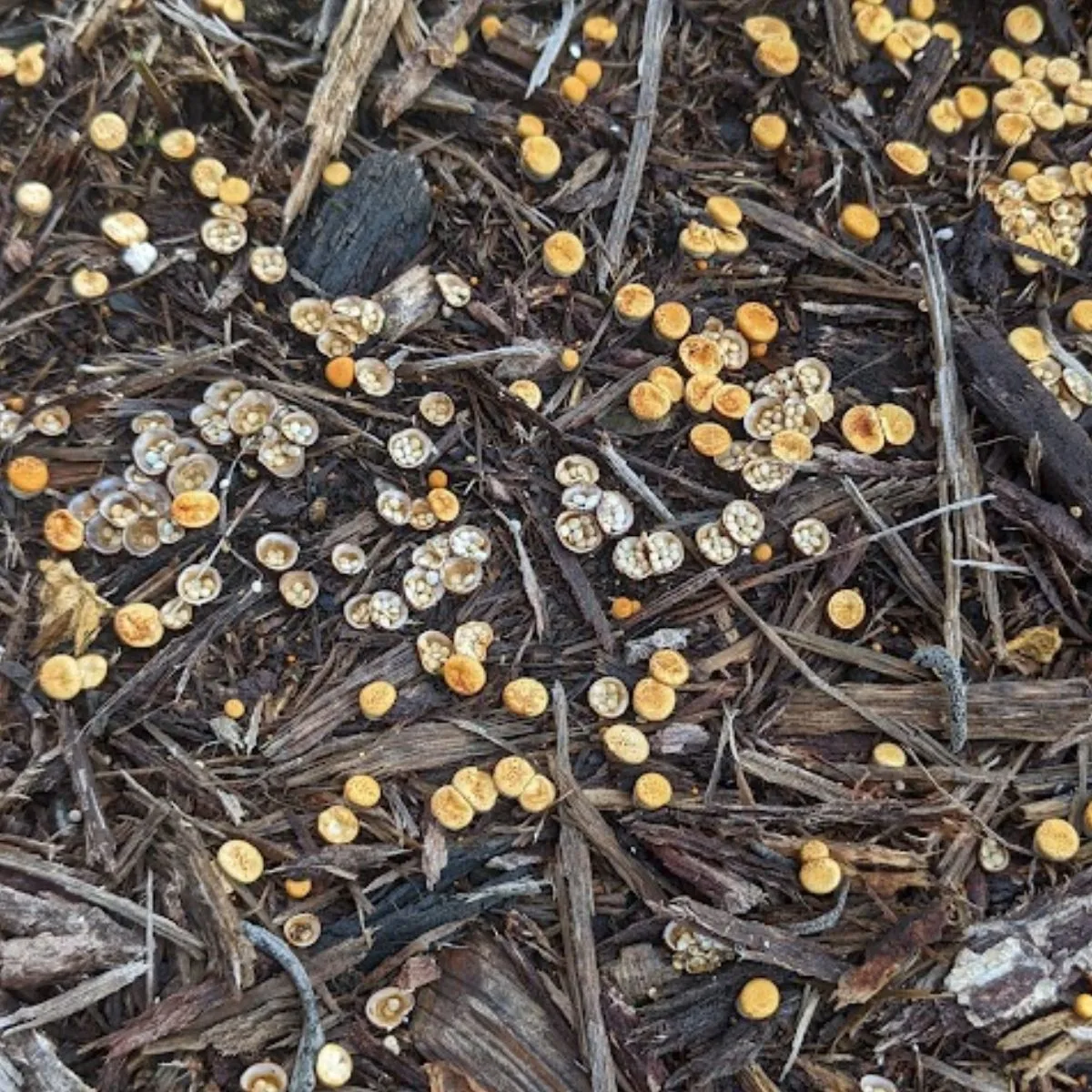
These tiny mushrooms are growing at the base of my rose plants, and a few are also in my lavender field.
More yard mushrooms

These little gray mushrooms are all over our backyard in between our clover ground cover.
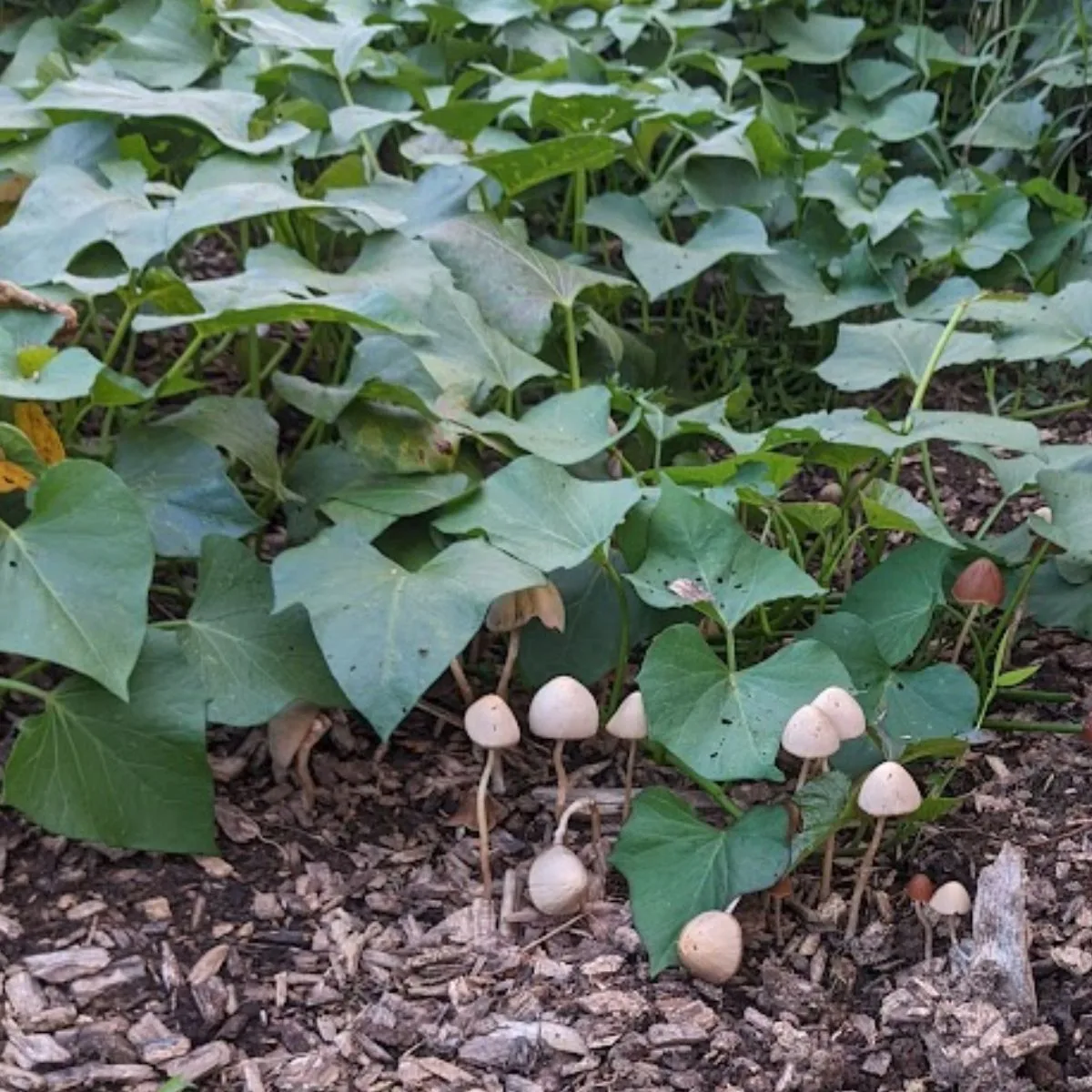
We are growing sweet potatoes for the first time, and these cute little mushrooms joined in: our wood chips make a good mushroom growing medium.
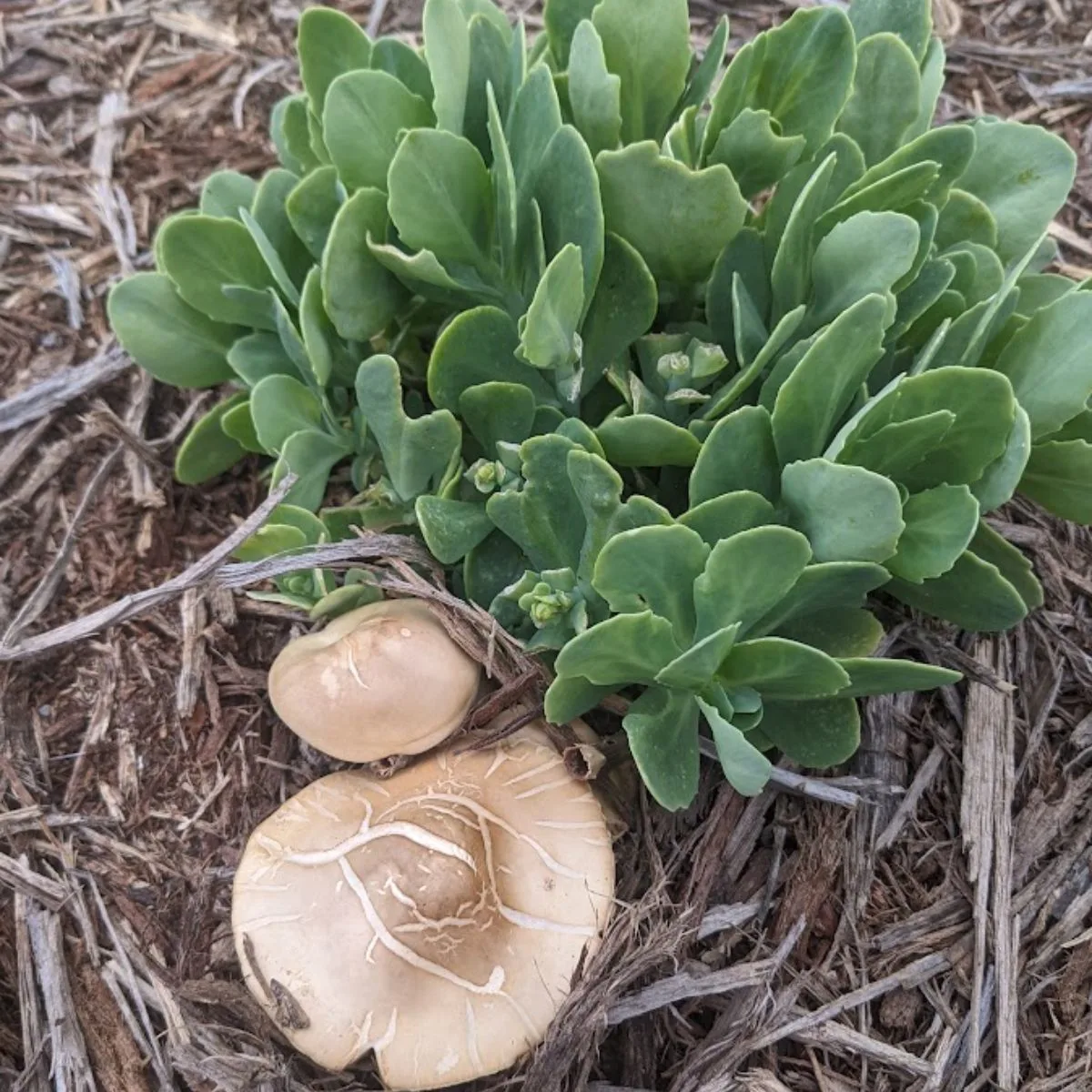
These thick, cracked-looking mushrooms are growing next to our beautiful pink sedum plants.
How to prevent mushrooms in a lawn
As mentioned above, removing mushrooms soon after they emerge will prevent them from spreading spores to other areas of your outdoor space. In lawns, mushrooms are often associated with overwatering or poor drainage, so addressing these conditions may help prevent the appearance of mushrooms. Irrigate only as necessary and aerate the soil for improved water penetration.
Similarly, if you notice mushrooms in your garden beds, check to see whether they indicate excessive moisture or simply the presence of healthy, rich soil. If the soil is too wet, reduce irrigation and use tilling or the addition of organic matter to improve drainage.
FAQs about mushrooms growing on the lawn
Are the mushrooms that grow in the lawn poisonous?
Because so many different types of mushrooms grow in lawns and gardens, some will be poisonous and some not. A few are even fatal. Never eat wild mushrooms unless you are a hundred percent certain what type they are and whether they are edible.
A good field guide can help you start with basic mushroom identification; guidance from an experienced mushroom hunter is even better. If your pet eats a mushroom, take a picture and gather a sample of the mushroom, if possible, and contact your vet. And make sure your children know never to eat a wild mushroom (or plant) without your approval.
Will mushrooms hurt my plants?
Nope! In fact, mushrooms are beneficial to plants because they decompose organic material and make the nutrients within it available to their root systems. The presence of mushrooms indicates healthy soil.
Is it a good idea to kill mushrooms using a fungicide?
Fungicides are not recommended for eradicating mushrooms. They are largely ineffective, and there are no approved fungicides for yard mushrooms. Plus, your plants need the mushrooms!
However you reacted to the sight of mushrooms in your lawn or garden before reading this article, I hope you can now recognize and appreciate their beneficial qualities. Let the mushrooms do their essential work of decomposing organic materials, and your plants will thank you.
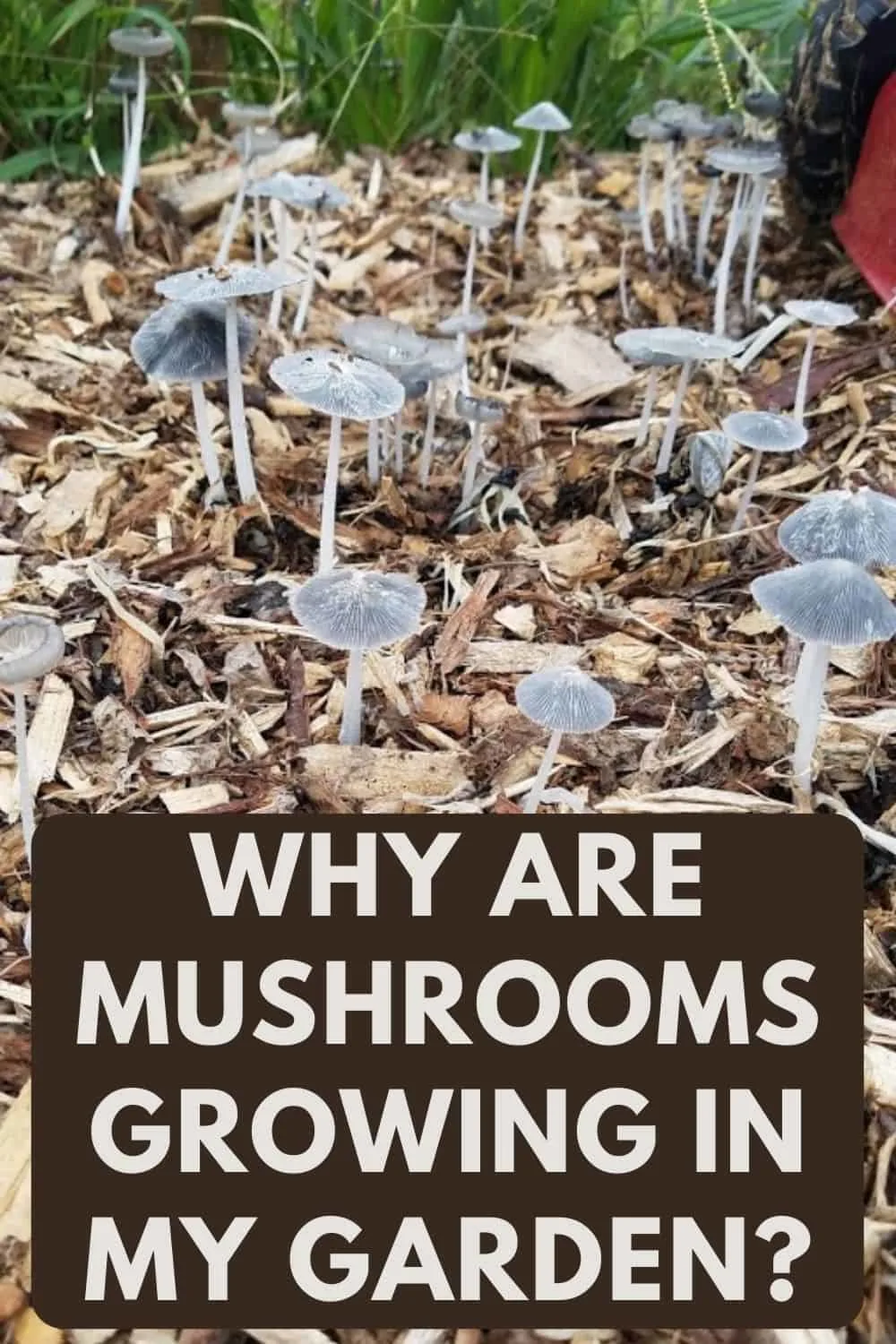
Serena Manickam is a freelance editor and writer and sustainable market gardener in rural Virginia. She holds a BA in environmental science and runs Fairydiddle Farm, a small market garden in which she grows no-spray produce and herbs to sell at a local farmer’s market.


Best Landscaping Ideas For Your Home
Saturday 6th of March 2021
[…] Why Are Mushrooms Growing In My Garden? […]
How To Compost With Worms
Friday 30th of October 2020
[…] Related: what does it mean if I have mushrooms growing in my garden? […]
How To Make Compost For Your Garden And Enjoy A Bountiful Harvest
Friday 30th of October 2020
[…] Why are mushrooms growing in my garden […]